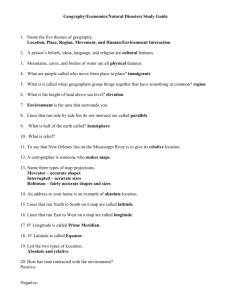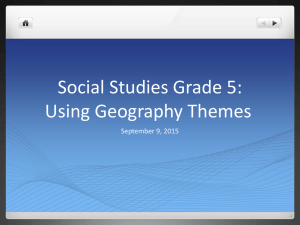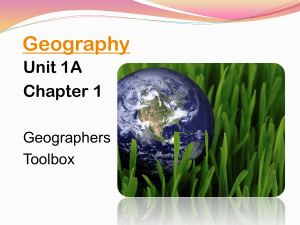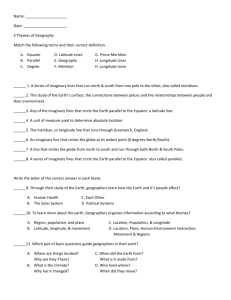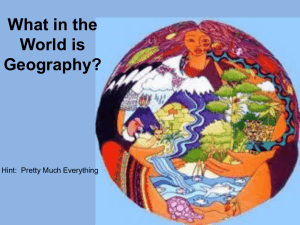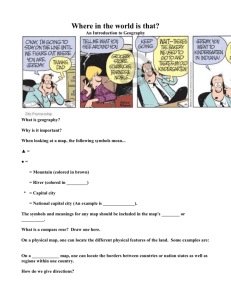World Geography
advertisement
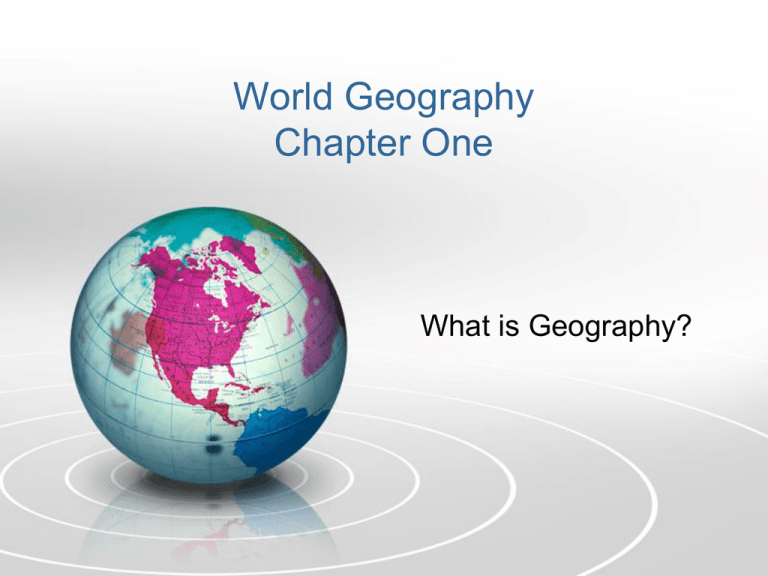
World Geography Chapter One What is Geography? Geography vs. Historians • Geography is the study of the distribution and interaction of physical and human features on earth. • Historians look at events over time • Geographers view the world by looking at the use of space on the earth and the interactions that take place there. 5 Themes of Geography • • • • Location-Where is it? Place-What is it like? Region-How are places similar or different? Human-Environment Interaction-How do people relate to the physical world? • Movement-How do people, goods, and ideas move from one location to another? Location (Where is it) • Absolute location-is the exact place on earth where a geographic feature, such as a city, is found. – Earth is divided into two equal halves. Each half of the globe is called a hemisphere. – The earth’s hemisphere can be north and south or east and west. – Equator-is the imaginary line that divides the north and south halves. – Prime meridian-is the imaginary line dividing the earth east and west. Location continued • Latitude lines- are imaginary lines that run parallel to the equator. • Geographers use these lines to locate places north or south. • The equator is designated as the zero-degree line for latitude. • Lines north of the equator are called north latitude lines and lines south of the equator are called south latitude lines. • Longitude lines-are imaginary lines that go around the earth over the poles. • To complete the grid system, geographers use longitude lines to mark positions in the east and west hemispheres. The prime meridian is the zero-degree line for longitude. • Each place on earth can have only one absolute location. Location continued • Relative location-describes a place in comparison to other places around it. • Example: I live 3 blocks south from Sonic. • Relative location helps you become familiar with the specific characteristics of a place. Place (What is it like?) • Place includes the physical features and cultural characteristics of a location. • All locations have physical features that set them apart, such as climate, landforms, and vegetation. • Can physical features and cultural characteristics change in a location? Region (How are places similar or different?) • Region is an area of the earth’s surface with similar characteristics. • They usually have more than one characteristic that unifies them. • These may include physical, political, economic, or cultural characteristics. • Geographers categorize regions in three ways: formal, functional, and perceptual regions. • Formal regions are defined by a limited number of related characteristics. Examples are the United States and Canada, Latin America, Europe, Africa, etc. • Functional regions is organized around a set of interactions and connections between places. Examples are city and its suburbs. Functional regions deal with movement back and forth: trains, subways, bus lines, etc. • Perceptual regions is a region in which people perceive, or see, the characteristics of the region in the same way. Examples: Midwest, South, North, etc. Human-Environment Interaction (How do people relate to the physical world?) • Refers to the relationship between humans and their environment. • People learn to use or deal with what the environment offers them and to change that environment to meet their needs. • Not everyone agrees with their environment or feels the same way about it. Movement (How do people, goods, and ideas move from one location to another?) • Geographers are interested in the ways people, goods, and ideas move from place to place. • Examples: clothes you wear, music you listen to, entertainment. • Geographers analyze movement by looking at three types of distance: linear distance, time distance, and psychological distance. • Linear distance simply means how far across the earth a person, an idea, or product travels. • Time distance is the amount of time it takes for a person, an idea, or product to travel. • Psychological distance refers to the way people view distance. – Psychological distance may influence decisions about many different human activities. Geographer’s Tools • Maps, Globes, and Data • The oldest known map is a Babylonian Clay tablet created about 2500 years ago. The tablet is about four inches high and shows the Babylonian world surrounded by water. • Two or Three Dimensions • A globe is a three-dimensional representation of the earth. It provides a way to view the earth as it travels through space. • Maps are two-dimensional graphic representations of selected parts of the earth’s surface. Maps are portable and can be drawn to any scale needed. • Three types of maps: general reference maps (natural and man made features on earth), thematic maps (climate or population density), and navigational maps (used by sailors and pilots). What is the difference between a GPS and a Compass? • A GPS determines absolute location. • A Compass determines direction. Reading a Map • • • • • • • Title-name of map Compass Rose-north, south, east, and west Labels-explain features on the map Legend or Key-explains symbols and colors Latitude and Longitude Scale-ratio between length on map and distance on earth Symbols-represent capital cities, economic activities, natural resources etc. • Colors-represent a variety of information on a map. 2 Types of Maps • Physical maps-help you see the types of landforms and bodies of water found in a specific area. On a physical map color, shading, or contour lines are used to indicate elevation or altitude. • Political maps-show features on the earth’s surface that humans created. Cities, states, territories, or countries are examples of a political map.
